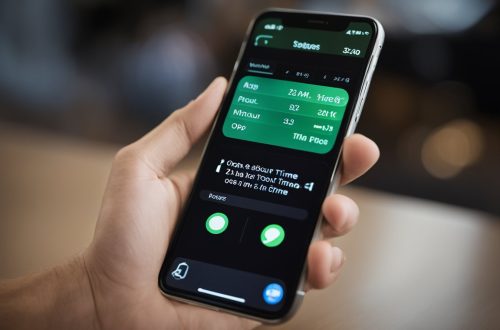How Can You Create a Healthy Balance between Online And Offline Time? Unplug & Recharge
To create a healthy balance between online and offline time, set boundaries and schedules. Prioritize activities that promote well-being and social connections.
In today’s digital age, finding a balance between online and offline activities is essential for overall well-being. With the prevalence of technology and constant connectivity, it’s easy to get consumed by screens and virtual interactions. However, excessive screen time can lead to negative consequences such as decreased physical activity, disrupted sleep patterns, and social isolation.
By establishing boundaries, setting aside dedicated offline time, and engaging in activities that promote face-to-face interactions and self-care, individuals can achieve a healthier balance in their lives. This balance is crucial for maintaining mental and physical health, fostering relationships, and enhancing overall quality of life.
The Digital Dilemma
Living in the digital age, it’s easy to get carried away with the constant need to be connected. With smartphones and other devices always within reach, it’s becoming increasingly difficult to find a healthy balance between online and offline time. This is what we call the Digital Dilemma. In this blog post, we will explore the rise of the screen age and the consequences of being always online. We will also provide tips on how to create a healthy balance between your digital and offline life.
The Rise Of The Screen Age
With the rise of technology, we have become more reliant on screens than ever before. From smartphones and laptops to tablets and TVs, we spend a significant amount of time staring at screens. According to a study, an average American spends more than 11 hours a day interacting with screens. This has led to an increase in digital addiction, which has several negative effects on our mental and physical health.
Consequences Of Being Always Online
Being always online has several consequences, including:
- Increased stress: Constant notifications and the need to stay updated can lead to increased stress levels.
- Decreased productivity: Being always online can lead to distractions, which can decrease productivity levels.
- Poor sleep quality: The blue light emitted by screens can disrupt our sleep patterns, leading to poor sleep quality.
- Decreased social interaction: Spending too much time online can lead to decreased face-to-face social interaction.
These are just a few of the negative effects of being always online. It’s important to find a healthy balance between your digital and offline life to avoid these consequences.
Now that we’ve discussed the rise of the screen age and the consequences of being always online, let’s look at some tips on how to create a healthy balance between your digital and offline life.
Assessing Your Screen Time
Achieving a healthy balance between online and offline time involves assessing your screen time. Set boundaries, prioritize activities, and take regular breaks to maintain a well-rounded lifestyle. Remember to engage in physical activities, connect with loved ones, and enjoy hobbies to enhance overall well-being.
Assessing Your Screen Time In our digital age, it’s crucial to assess your screen time to maintain a healthy balance between online and offline activities. By understanding how much time you spend on digital devices, you can make informed decisions to prioritize your well-being.Tools To Track Digital Usage
There are various tools available to help you monitor your digital consumption. Consider using apps like Screen Time (iOS) or Digital Wellbeing (Android) to track the time spent on different apps and set limits accordingly.Signs Of Excessive Screen Time
Excessive screen time can lead to issues such as eye strain, poor posture, and sleep disturbances. Be mindful of signs like headaches, fatigue, and irritability, which may indicate that you need to reduce your digital exposure.Setting Boundaries
Setting boundaries is a crucial step in creating a healthy balance between online and offline time. By establishing clear guidelines, you can ensure that technology enhances rather than dominates your daily life.
Designating Tech-free Zones
Designating specific areas in your home as tech-free zones can help you and your family disconnect from digital distractions. For example, the dining area can be a designated tech-free zone, encouraging meaningful conversations during meals without the interference of screens.
Creating Screen Time Limits
Setting specific time limits for screen usage is essential for maintaining a healthy balance. This can involve allocating a certain number of hours per day for recreational screen time, ensuring that individuals have ample opportunities for offline activities and social interactions.
Quality Offline Activities
Engaging in Quality Offline Activities is essential for achieving a healthy balance between online and offline time. Quality offline activities can help reduce screen time and promote overall well-being. It’s important to prioritize activities that provide physical and mental stimulation while fostering real connections with the world around us.
Engaging In Physical Exercise
Physical exercise is a fantastic way to disconnect from the digital world and reconnect with our bodies. Whether it’s a brisk walk in nature, a yoga session, or a game of basketball, physical activity not only promotes fitness but also enhances mental clarity and emotional well-being.
Rediscovering Offline Hobbies
Rediscovering offline hobbies is an effective way to shift focus away from screens. Engaging in activities such as painting, gardening, knitting, or playing a musical instrument can provide a sense of fulfillment and creativity that is often lacking in the digital realm.
Mindfulness And Technology
When it comes to maintaining a healthy balance between online and offline time, practicing mindfulness and being conscious of our technology usage plays a crucial role. Mindfulness encourages us to be present in the moment and aware of our actions, enabling us to make mindful choices about our online and offline activities.
Practicing Digital Detox
Digital detox involves taking a break from technology to reconnect with the physical world and recharge our mental batteries. This can be achieved by setting aside designated time periods, such as evenings or weekends, to unplug from devices and engage in offline activities. It allows us to reconnect with nature, pursue hobbies, and spend quality time with loved ones without digital distractions.
Mindful Use Of Social Media
Mindful use of social media involves being selective about the platforms we engage with and the content we consume. It’s important to curate our social media feeds to include positive and uplifting content while limiting exposure to negative or triggering material. Setting boundaries around social media usage and being conscious of our emotional responses to online interactions can help maintain a healthy relationship with these platforms.
Family, Friends, And Unplugging
Creating a healthy balance between online and offline time is essential for maintaining strong relationships with family and friends. By unplugging from technology and spending quality time with loved ones, you can foster deeper connections and create lasting memories. In this section, we will explore the importance of tech-free family time and the benefits of encouraging group activities.
Tech-free Family Time
Tech-free family time allows for genuine interaction and bonding without the distractions of screens and devices. Establishing designated periods for unplugging can create a harmonious environment where family members engage in meaningful conversations and activities. Whether it’s enjoying a meal together or participating in outdoor adventures, setting aside specific times for tech-free family bonding can strengthen relationships and nurture a sense of togetherness.
Encouraging Group Activities
Encouraging group activities provides an opportunity for family and friends to engage in shared experiences that promote unity and camaraderie. Planning outings, game nights, or collaborative projects encourages teamwork and fosters a sense of belonging. By engaging in group activities, individuals can develop essential social skills while creating cherished memories with their loved ones.
Balancing Work And Life
When balancing work and life, creating a healthy relationship between online and offline time is crucial for overall well-being.
Managing Work Communications
- Set specific times for checking emails and messages.
- Utilize tools like email filters to organize and prioritize communication.
- Establish boundaries by communicating availability to colleagues.
Prioritizing Offline Relaxation
- Schedule regular digital detox periods to unwind.
- Engage in offline hobbies such as reading or outdoor activities.
- Practice mindfulness techniques to stay present and reduce screen time.
Embracing The Unconnected Moments
Discover the art of embracing unconnected moments to strike a healthy balance between online and offline time. By consciously unplugging, you can nurture real-life connections, reduce screen time, and enhance overall well-being. Prioritize mindfulness and engage in offline activities to foster a harmonious digital lifestyle.
In today’s world, it’s challenging to maintain a balance between online and offline time. The internet and social media platforms have become an integral part of our daily routine, and it’s hard to imagine a life without them. However, it’s important to realize that spending too much time online can have adverse effects on our mental and physical health. That’s why it’s crucial to embrace the unconnected moments in our lives and find joy in solitude and appreciate the natural world around us.Finding Joy In Solitude
Spending time alone can be a daunting experience for many people, but it’s essential for our mental well-being. It allows us to reflect on our thoughts and emotions and helps us recharge our batteries. To find joy in solitude, you can try activities like reading a book, writing in a journal, or meditating. These activities will help you disconnect from the online world and reconnect with yourself.Appreciating The Natural World
In our fast-paced lives, we often forget to appreciate the beauty of the natural world around us. Spending time in nature has numerous benefits for our mental and physical health. It can reduce stress, improve mood, and increase creativity. You can start by taking a walk in a park or hiking in the mountains. Make it a habit to spend time in nature at least once a week, and you’ll notice a significant improvement in your overall well-being. In conclusion, finding a healthy balance between online and offline time is crucial for our well-being. Embracing the unconnected moments in our lives can help us reconnect with ourselves and appreciate the world around us. So, take some time off from the online world, and start enjoying the simple things in life.Strategies For A Balanced Digital Diet
Adopting A Tech-life Balance Plan
Creating a healthy balance between online and offline time is essential for overall well-being. One effective strategy is adopting a tech-life balance plan. This involves setting clear boundaries and allocating specific time for digital activities and offline pursuits. By consciously managing screen time, individuals can cultivate a healthier relationship with technology, leading to improved mental and physical health.
Regular Check-ins And Adjustments
Another crucial aspect of maintaining a balanced digital diet is the practice of regular check-ins and adjustments. This involves periodically evaluating one’s digital habits and making necessary changes to ensure a healthy balance. By consistently monitoring screen time and assessing its impact on daily life, individuals can proactively address any imbalances and make adjustments as needed, fostering a sustainable and harmonious relationship with technology.
The Benefits Of A Balanced Life
Maintaining a balanced life involves setting boundaries for online and offline activities. Allocate specific time for both to enhance overall well-being and productivity. By creating this healthy equilibrium, you can enjoy the benefits of reduced stress and improved relationships.
Maintaining a healthy balance between online and offline time is crucial for overall well-being. Achieving this balance offers numerous advantages that contribute to a fulfilling and enriching lifestyle.Improved Mental Health
Balanced living promotes positive mental health by reducing stress and anxiety levels. It allows for time for self-care, relaxation, and rejuvenation.Strengthened Personal Relationships
Balancing online and offline activities nurtures personal connections with loved ones. It fosters effective communication and quality time spent together.Frequently Asked Questions
How Can You Create A Healthy Balance Between Online And Offline?
To create a healthy balance between online and offline, limit screen time, prioritize real-life interactions, and engage in hobbies or activities. Schedule tech-free time and set boundaries to maintain a healthy balance. Regularly assess and adjust your habits to ensure a healthy offline and online equilibrium.
How Do You Balance Your Internet Online And Offline Schedule?
To balance your online and offline schedule, set specific times for each activity and stick to them. Use productivity tools to manage your time and prioritize tasks. Take breaks and practice self-care to avoid burnout. Limit distractions and stay focused on the task at hand.
Communicate your schedule with others to avoid conflicts.
How To Balance Offline And Online Time?
To balance offline and online time, set specific schedules, limit screen time, engage in hobbies, and prioritize real-life interactions.
How To Keep A Healthy Balance Between Screen Time And Offline Time?
To maintain a healthy balance, limit screen time, take regular breaks, engage in physical activities, and connect with others offline. Set boundaries and create tech-free zones at home to encourage offline activities.
Conclusion
Finding a healthy balance between online and offline time is crucial for overall well-being. By setting boundaries, prioritizing activities, and being mindful of screen time, you can achieve this balance. Remember to engage in offline activities that bring you joy and connection, while also utilizing technology purposefully.
Striking this equilibrium will lead to a more fulfilling and enriched life.


